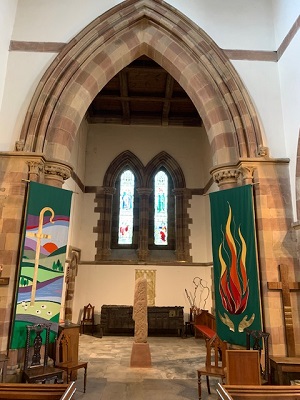
The tower was designed, in 1868, by the important Architects E G Paley and Hubert Austin. Its cost of £2,054 was met by the Argles family, of Eversley House, Leasgill, local landowners whose main wealth derived from the Port of Liverpool. It replaced a medieval tower whose round headed Norman tower arch to the nave dated from c 1150. Over the centuries, its field rubble masonry had been weakened by burials under the foundations. One female skeleton had been interred right across the footings of the north wall, causing a crack disguised by centuries of lime wash which covered external walls until the 19th century.
The new tower was built at almost twice the height of its predecessor so that, it was said, it could be seen from the Argles’ estates in the Lyth Valley. Crosthwaite’s church tower built in 1868, by the same benefactors, resembles the Heversham tower, although it was designed by another architect, Joseph Bintley. Massively constructed of machine cut limestone with sandstone dressings, it was built to hold a peal of five new bells weighing five hundredweight, cast by Warners of London and paid from a donation of £500 from the Misses Woods of Elm Lawn, later The Heversham Hotel. The bells are inscribed, respectively,
- ‘Let him that athirst is come’
- ‘Whomsoever will let him take of water of life freely’
- ‘Jesus Christ the same yesterday today and forever’
- ‘Blessed be God and father of our Lord Jesus Christ, and
- ‘Praise the Lord O my soul and forget not all his benefits’.
An underground boiler house provided a coke fuelled central heating system, for which decorative iron vents, now disused, remain in the floors.
The tower clock contains works from a clock made in 1860, but its maroon face was prescribed by Austin. A 1631 note of ‘one shilling paid for coulers for the diall’ is one of the earliest local references to a parish clock.
The seating under the tower was composed of panelled oak pews dating from 1814. Made by Burrow of Sandside, they had originally been installed in the nave and were intended to accommodate worshippers who had formerly occupied the gallery, removed in 1870. In 2023, the fixed seating was removed to provide a display area centred on the Anglo-Saxon cross which had been transferred from behind the door in the porch, and also the Medieval parish chest, originally in the vestry.
Next: The north aisle